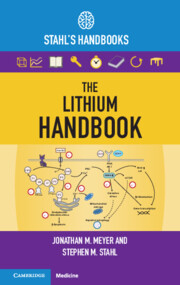Book contents
- The Lithium Handbook
- Reviews
- The Lithium Handbook
- Copyright page
- Contents
- Foreword
- Preface: How to Use This Handbook
- Introduction
- 1 The Efficacy Story
- 2 Renal Handling of Lithium
- 3 Clinical Pharmacokinetics
- 4 Lithium Initiation and Monitoring
- 5 Management of Routine Lithium Related Adverse Effects
- 6 Lithium Toxicity
- 7 Special Populations and Circumstances
- 8 Lithium Discontinuation
- Index
- References
5 - Management of Routine Lithium Related Adverse Effects
Polyuria, Gastrointestinal Complaints; Altered Taste; Weight Gain; Thyroid and Parathyroid Dysfunction; ECG Changes; Hair Loss; Acneiform Eruptions and Other Skin Disorders; Neutrophilia; CNS Complaints (Tremor, Fatigue, Cognitive and Emotional Dulling, Nystagmus, Myoclonus and Idiopathic Intracranial Hypertension); Peripheral Edema
Published online by Cambridge University Press: 09 February 2024
- The Lithium Handbook
- Reviews
- The Lithium Handbook
- Copyright page
- Contents
- Foreword
- Preface: How to Use This Handbook
- Introduction
- 1 The Efficacy Story
- 2 Renal Handling of Lithium
- 3 Clinical Pharmacokinetics
- 4 Lithium Initiation and Monitoring
- 5 Management of Routine Lithium Related Adverse Effects
- 6 Lithium Toxicity
- 7 Special Populations and Circumstances
- 8 Lithium Discontinuation
- Index
- References
Summary
Despite recent downward trends in lithium use for bipolar disorder (BD) [1], nearly every treatment guideline, meta-analysis or review published in the last decade has reinforced the notion that lithium remains the mood stabilizer of choice for acute or maintenance therapy in those with a history of mania (BD-1, schizoaffective disorder, bipolar type [SAD-BT]), and an important treatment option for other mood disorder spectrum patients (BD-2, unipolar major depressive disorder [MDD]) [2–4].
- Type
- Chapter
- Information
- The Lithium HandbookStahl's Handbooks, pp. 251 - 328Publisher: Cambridge University PressPrint publication year: 2023

